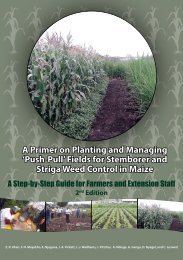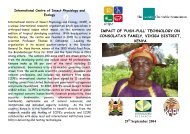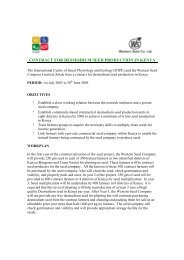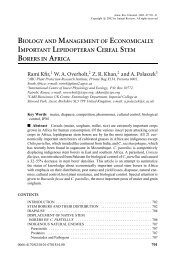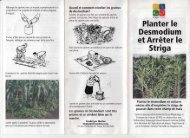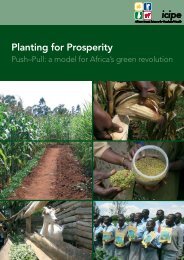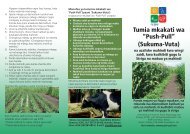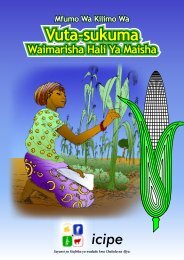The Royal Society Report - Push-Pull
The Royal Society Report - Push-Pull
The Royal Society Report - Push-Pull
Create successful ePaper yourself
Turn your PDF publications into a flip-book with our unique Google optimized e-Paper software.
Figure 2.1. Global soil degradation. Source: UNEP (2009).<br />
attributes, both beneficial and adverse. <strong>The</strong> latter relates to<br />
the population densities and identities of resident pests<br />
and diseases as well as the beneficial soil flora and fauna<br />
that sustain soil ecosystem functions (eg nitrification,<br />
aeration, nutrient cycling) and counter adverse impacts (eg<br />
denitrification or regulation of pest populations).<br />
2.5.1 Microbiological properties of soil<br />
<strong>The</strong> microbial diversity in a fertile soil has been compared<br />
to the biodiversity of a tropical rain forest (Beneddeti et al.<br />
2005). Soil fungi and bacteria are critical for the recycling<br />
of carbon and major nutrients, particularly nitrogen, from<br />
organic inputs derived from plants and animals. Inputs of<br />
organic material in the form of crop residues and animal<br />
manures encourage the maintenance of an active microbial<br />
population, although the impact of soil use (eg for<br />
different crops) on microbial diversity is not well studied.<br />
Much soil microbial diversity is maintained in a dormant<br />
condition (spores and other resting structures) and the<br />
majority of microbial activity is associated with the zone<br />
surrounding plant roots (rhizosphere) where other impacts<br />
such as enhanced nutrient uptake (mycorrhizae) and<br />
amelioration of root diseases (biocontrol) can occur. Soil<br />
microbes also contribute to the maintenance of a friable<br />
soil structure.<br />
2.5.2 Physical properties of soil<br />
<strong>The</strong> physical properties of soil are determined by the<br />
underlying geology, the way it has been managed in the<br />
past and the way it is currently managed. A soil that is<br />
resistant to wind and water erosion is usually also a soil<br />
that readily allows water infiltration (ie is well drained) and<br />
has a high water-holding capacity. <strong>The</strong>se characteristics are<br />
strongly correlated with adequate organic matter content<br />
resulting from animal manures and return of crop residues.<br />
Organic matter also encourages microbial activity and<br />
nutrient recycling.<br />
A well-drained, well-aerated, friable soil that is not<br />
compacted promotes high crop productivity when water<br />
and nutrients are not limited. Good seed beds conducive to<br />
the germination, emergence and establishment of annual<br />
crops raised from seed are easier to prepare from well<br />
structured soils. In addition, the energy required for<br />
cultivation is significantly less in well structured soils. For<br />
example, it has been demonstrated that the energy savings<br />
from incorporating wheat straw into arable soils to improve<br />
soil conditioning are greater than the use of that straw as<br />
an off-take feedstock for the production of biofuels or<br />
electricity via combustion (Powlson et al. 2008).<br />
In regions where soil of appropriate quality is in short<br />
supply, artificial growing media can be used. <strong>The</strong>se may be<br />
solution culture, rockwool or coir in glasshouse production.<br />
Increasingly waste products may be digested to produce<br />
an inert growing substrate to which microbes and nutrients<br />
can be added. This approach can not only contribute to the<br />
production of artificial ‘soils’ but also result in the<br />
generation of CO 2 and energy that can be used in the<br />
production process.<br />
2.5.3 Salinity<br />
Of the land farmed in dry-land agriculture, about 2% is<br />
affected by secondary salinity. Of the irrigated land, 20% is<br />
14 I October 2009 I Reaping the Benefits <strong>The</strong> <strong>Royal</strong> <strong>Society</strong>



